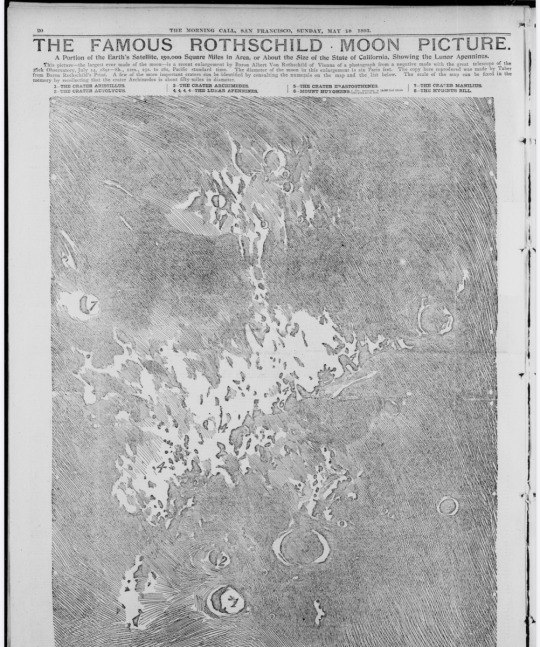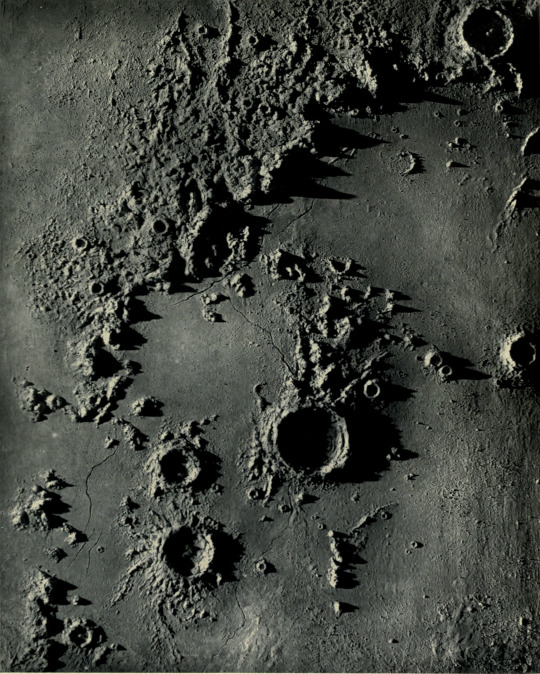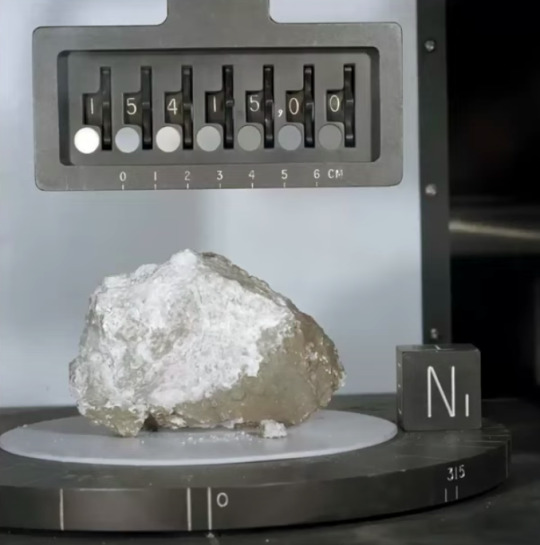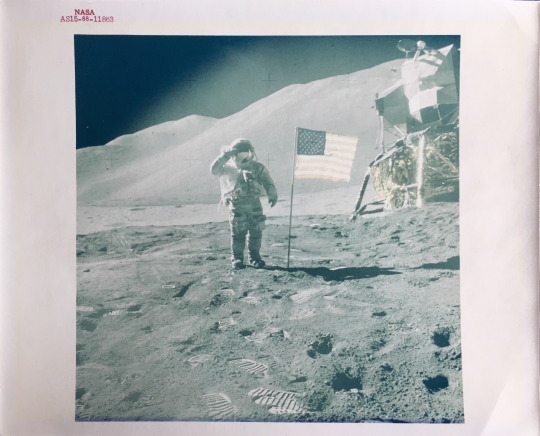#lunar Apennine
Text

Mare Imbrium around Montes Apenninus l Kevin Earp
#moon#mare imbrium#solar system#astrophotography#astronomy#nasa#galaxy#Montes Apenninus#stars#space#universe#night#planets#sky#lunar Apennine
453 notes
·
View notes
Text

The crater Eratosthenes at the end of Montes Apenninus // Dimitrios Georgomanos
Eratosthenes crater is named after the Greek mathematician Eratosthenes of Cyrene (276 - 194 BC). He is perhaps best known for calculating the circumference of the Earth within 2% of the modern value!
The Montes Apenninus is named after the Apennine Mountains that form the peninsula of Italy.
#astronomy#astrophotography#solar system#moon#the moon#luna#lunar surface#lunar crater#crater#eratosthenes#montes apenninus#apennine mountains
36 notes
·
View notes
Text

Apollo 15's Home on the Moon - February 22nd, 1996.
"The lunar module shown above, named "Falcon," served as home for Apollo 15 astronauts David Scott and James Irwin during their stay on the Moon in July and August of 1971. Meanwhile, astronaut Alfred Worden circled in the command module overhead. Harsh sunlight on the grey lunar surface lends the image an eerie quality, while the Lunar Apennine Mountains frame the background with Mount Hadley Delta visible on the right. Visible in the foreground are tracks from the first Lunar Roving Vehicle, an electric car which enabled the astronauts to explore extended areas on the lunar surface. Apollo 15 confirmed that most lunar surface features were created by impacts. Rocks returned by the Apollo 15 crew included green glasses whose formation mechanism is unclear."
47 notes
·
View notes
Photo



NASA's Lucy spacecraft provides new views of the moon TOP IMAGE...NASA's Lucy spacecraft captured this image of the moon's surface on Oct 16, 2022, about 6.5 hours after it flew by the Earth for its first of three gravity assists. The image was taken while Lucy was between the Earth and the moon, approximately 160,000 miles (260,000 km) from the moon, so it shows shows a perspective familiar to Earth-based observers. The image is of a 800 mile (1200 km) wide patch near the center of the last quarter moon. Many familiar craters are visible, including the relatively fresh crater Arzachel just left of center. The prominent fault scarp called the Straight Wall is visible cutting across the lava plains to the lower left of center. The image, which is made by combining ten separate 2 millisecond exposures of the same scene to maximize image quality, has been sharpened. Each pixel represents approximately 0.8 miles (1.3 km). This image was taken with L'LORRI (Lucy LOng Range Reconnaissance Imager), Lucy's high resolution greyscale imager. L'LORRI was provided and operated by Johns Hopkins Applied Physics Laboratory. CENTRE IMAGE Terminator mosaic NASA's Lucy spacecraft captured this mosaic of the moon's surface on Oct 16, 2022, between 7.5 and 8 hours after it flew by the Earth for its first of three gravity assists. At its closest approach, the flyby took the spacecraft within 224 miles (360 km) of the Earth, passing below the altitude of the international space station. Lucy was an average of approximately 140,000 miles (230,000 km) from the moon when these images were taken. The mosaic was taken while Lucy was between the Earth and the moon, so it shows a perspective familiar to Earth-based observers, centered near the terminator of the last quarter moon. The view includes the rugged, heavily cratered, Southern Highlands near the bottom of the mosaic, and the ancient, lava-filled impact basin Mare Imbrium near the top. The bright, fresh crater Copernicus is conspicuous near the left edge of the mosaic. This mosaic, which is made from 5 separate 1 millisecond exposures, has been sharpened. Note that the image covering the uppermost portion of the edge of the moon was taken at an earlier time, resulting in a small mismatch in the images there. Each pixel represents approximately 0.7 miles (1.2 km). LOWER IMAGE....Single frame of Mare Imbrium NASA's Lucy spacecraft captured this image of the moon's surface on Oct 16, 2022, about 8 hours after it flew by the Earth for its first of three gravity assists. The image was taken while Lucy was between the Earth and the moon, so it shows a perspective familiar to Earth-based observers. The image shows a roughly 600 mile (1000 km) wide swath of lunar terrain, dominated by the ancient, lava-filled impact basin Mare Imbrium. The Apennine Mountains, part of the Imbrium basin rim, which were the landing site for the Apollo 15 mission in 1971, dominate the lower-right portion of the image. Lucy was approximately 140,000 miles (230,000 km) from the moon when the image was taken. The image, which is a single 1 millisecond exposure, has been sharpened. Each pixel represents approximately 0.7 miles (1.1 km).
12 notes
·
View notes
Text
Apollo 15 Catches Earth on the Horizon

This view of the crescent Earth over the Moon's horizon was taken during the Apollo 15 lunar landing mission. Apollo 15 launched from the Kennedy Space Center on July 26, 1971 via a Saturn V launch vehicle. Aboard was a crew of three astronauts: David R. Scott, mission commander; James B. Irwin, lunar module pilot; and Alfred M. Worden, command module pilot.
Designed to explore the Moon over longer periods, greater ranges, and with more instruments for the collection of scientific data than before, Apollo 15 included the introduction of a $40 million lunar roving vehicle (LRV) that reached a top speed of 16 kph (10 mph) across the Moon's surface.
The successful Apollo 15 lunar landing mission was the first in a series of three advanced missions planned for the Apollo program. The primary scientific objectives were to observe the lunar surface, survey and sample material and surface features in a preselected area of the Hadley-Apennine region, setup and activate surface experiments, and conduct in-flight experiments and photographic tasks from lunar orbit. Apollo 15 televised the first lunar liftoff and recorded a walk in deep space by Worden. Both the Saturn V rocket and the LRV were developed at the Marshall Space Flight Center.
Image Credit: NASA
Apollo
3 notes
·
View notes
Text
The Famous Rothchild Moon Picture
The Famous Rothchild Moon Picture
The Famous Rothchild Moon
This image was published on Sunday May 28th 1893 in The Morning Call, San Francisco. Transcript below.
A portion of the Earth’s Satellite, 150,000 square miles in area, or about the size of the State of California, showing the Lunar Apennines.
This picture – the largest ever made of the moon – is a recent enlargement by Baron Albert Von Rothchild of Vienna of a…

View On WordPress
0 notes
Photo

“The Lunar Apennines, Archimedes.” The moon : considered as a planet, a world, and a satellite. 1874.
Internet Archive
2K notes
·
View notes
Photo

50 years ago... Apollo 15 safely returned to Earth...
August 7, 1971 after a 12 days 7 hours lunar spaceflight mission, the Apollo 15 crew was recovered in the North Pacific Ocean by USS Okinawa, greeted by Captain Huff & Rear Admiral Hayward.
Note Apollo 15 commander David Scott was clearly wearing his 44 mm diameter Bulova 885104 prototype chronograph he had been wearing since the third lunar EVA at Hadley Rille.
This means Scott wore the Bulova chronograph during the “Hammer & Feather” Galileo gravity field experiment, during the salute to the Stars & Stripes at the Hadley-Apennine lunar surface and while putting the memorial artwork “Fallen Astronaut” in the lunar soil.
Worn outside the Apollo A7LB spacesuit, this Bulova chronograph worked flawlessly onboard the Lunar Rover in the dusty lunar environment.
In October 2015, this Bulova chronograph with moondust-stained velcro strap was auctioned as the only privately-owned watch to be worn on the surface of the moon!
(Photo: NASA/US Navy)
#Apollo#Astronaut#Bulova#chronograph#Bulova moonwatch#NASA#USAF#US Navy#montres#military#uhren#wristwatch#MoonwatchUniverse#spaceflight#1971#time piece#Van Hoeydonck#Testpilot#The Right Stuff#watchlover#West Point#Zulu time
10 notes
·
View notes
Text

Here’s a satellite image of the moon from Hadley Rill. Originally, it’s origin was unknown—people thought it may have been ancient evidence for liquid water—what we know now is that it’s actually a lava channel that was carved and originally formed by the thermal erosion of lava across the surface. The Apollo 15 Mission landed just to the east of Hadley Rill, between the rill itself and the mountain ranges you see (known as the Apennine Mountains, some of the most ancient landscapes that we know of on the lunar surface).

Because our ability to precision land on the lunar surface and also because of the nice lunar rover that we had during the Apollo 15 Mission, you can see we were able to travel pretty far away from the landing site.

Here is just an image from one of the furthest locations... you’re about 2 miles away from the lunar lander that you can see off in the distance. The Apollo 15 Mission was able to travel quite a bit and look for different rocks and different geological features that might hint at the origin and geologic evolution of the moon.

One sample in particular caught the astronaut’s eye. You can see the sample just to the left of this little collection tool here.

This sample was perched upon this little clump of dirt. It’s this bright, white sample that was quite dirty at the time of collection but, cleaned off, has some really cool features to it.

Here is the Apollo 15 astronaut Dave Scott taking a look at that specific sample back in the laboratory after returning from his lunar mission.

The sample is defined as Apollo Sample 15415, also known as the “Genesis Rock”. The Genesis Rock is thought to be really important because of all this white, bright stuff contained within the sample. All this white material is plagioclase feldspar--a mineral very common on Earth--but this sample is completely composed of it. This rock was dated at about 4.2 billion years old; we were able to narrow down the hypotheses about lunar formation thanks to the old age of this rock and its chemical and isotopic composition.
7 notes
·
View notes
Photo

A close-up view of a commemorative plaque left on the Moon at the Hadley-Apennine landing site in memory of 14 NASA astronauts and USSR cosmonauts, now deceased.
Their names are inscribed in alphabetical order on the plaque. The plaque was stuck in the lunar soil by astronauts David R. Scott, Apollo 15 commander, and James B. Irwin, lunar module pilot, during their lunar surface extravehicular activity (EVA).
The tiny, figurine represents fallen astronauts and cosmonauts:
Charles A. Bassett II
Pavel I. Belyayev
Roger B. Chaffee
Georgi Dobrovolsky
Theodore C. Freeman
Yuri A. Gagarin
Edward G. Givens Jr.
Virgil I. Grissom
Vladimir Komarov
Viktor Patsayev
Elliot M. See Jr.
Vladislav Volkov
Edward H. White II,
Clifton C. Williams Jr.
While astronauts Scott and Irwin descended in the Lunar Module (LM) "Falcon" to explore the Hadley-Apennine area of the moon, astronaut Alfred M. Worden, command module pilot, remained with the Command and Service Modules (CSM) in lunar orbit.
https://solarsystem.nasa.gov/resources/2279/memorial-to-fallen-astronauts-on-the-moon/?utm_source=FBPAGE&utm_medium=NASA+-+National+Aeronautics+and+Space+Administration&utm_campaign=NASASocial&linkId=81477184&fbclid=IwAR2i1dwGq6U8HXPb8B5HgWCf_URxShTKPtL6PzLxWWxtiHefWwqdk-4jCt0
40 notes
·
View notes
Text
NASA Remembers Apollo 15 Astronaut Al Worden
NASA logo.
March 18, 2020
Former astronaut Alfred M. Worden, command module pilot on the Apollo 15 lunar landing, passed away March 18, 2020, in Texas.
"I’m deeply saddened to hear that Apollo astronaut Al Worden has passed away," NASA Administrator Jim Bridenstine tweeted about Worden. "Al was an American hero whose achievements in space and on Earth will never be forgotten. My prayers are with his family and friends."
As command module pilot, Worden stayed in orbit while commander David Scott and lunar module pilot James B. Irwin explored the Moon’s Hadley Rille and Appennine Mountains. Apollo 15’s command module, dubbed Endeavour, was the first to have its own module of scientific instruments. During the flight back from the Moon, Worden made three spacewalks to retrieve film from cameras in the module. Altogether, Worden logged more than 295 hours in space.
Image above: Astronaut Alfred M. "Al" Worden served as the command module pilot for Apollo 15 in 1971, the fourth lunar landing mission and the first to use a lunar rover. Remaining in orbit while commander David Scott and lunar module pilot James B. Irwin explored Hadley Rille and the Apennine Mountains, Worden photographed the lunar surface and made other observations. On the return trip to Earth, Worden made three spacewalks to retrieve film from an instrument module in the Apollo spacecraft. Image Credit: NASA.
“The thing that was most interesting to me was taking photographs of very faint objects with a special camera that I had on board,” Worden told Smithsonian Magazine in 2011. “These objects reflect sunlight, but it’s very, very weak and you can’t see it from [Earth]. There are several places between the Earth and the moon that are stable equilibrium points. And if that’s the case, there has to be a dust cloud there. I got pictures of that.”
Like other command module pilots, Worden stayed as busy as his colleagues on the surface. But he also took some time to enjoy the view.
“Every time I came around the moon I went to a window and watched the Earth rise and that was pretty unique.”
After retirement from active duty in 1975, Worden became President of Maris Worden Aerospace, Inc., and was Vice-President of BF Goodrich Aerospace Brecksville, Ohio, in addition to other positions within the aerospace and aviation industries. Worden wrote several books: a collection of poetry, “Hello Earth: Greetings from Endeavour” in 1974; a children’s book, “I Want to Know About a Flight to the Moon”, also in 1974; and a memoir, “Falling to Earth,” in 2011. His interest in educating children about space led to an appearance on “Mr. Rogers’ Neighborhood”.
NASA Remembers Apollo Astronaut Al Worden
Worden was born Feb. 7, 1932, in Jackson, Michigan, on February 7, 1932. He was appointed to the United States Military Academy at West Point, graduating in 1955. He earned master of science degrees in astronautical/aeronautical engineering and instrumentation engineering from the University of Michigan in 1963. In 1971, the University of Michigan awarded him an honorary doctorate of science in astronautical engineering.
Before becoming an astronaut, Worden was an instructor at the Aerospace Research Pilots School. He had also served as a pilot and armament officer from March 1957 to May 1961 with the 95th Fighter Interceptor Squadron at Andrews Air Force Base, Maryland.
Worden was one of 19 astronauts selected by NASA in April 1966. He served as a member of the astronaut support crew for Apollo 9 and as backup command module pilot for Apollo 12.
After leaving the astronaut corps, Worden moved to NASA’s Ames Research Center in Mountain View, California. He was the Senior Aerospace Scientist there from 1972-73, and then chief of the Systems Study Division until 1975.
Al Worden’s full NASA biography (dated December 1993):
https://www.nasa.gov/sites/default/files/atoms/files/worden_alfred.pdf
Image (mentioned), Video (NASA), Text, Credits: NASA/Brian Dunbar.
R.I.P.; Orbiter.ch
Full article
20 notes
·
View notes
Photo

Vintage Nasa Photograph
25.4 cm x 20.1 cm, Vintage Chromogenic Print on Kodak Paper
Red Serial Number
AS15-88-11863 (1 Aug. 1971) ---
Astronaut David R. Scott, commander, gives a military salute while standing beside the deployed United States flag during the Apollo 15 lunar surface extravehicular activity (EVA) at the Hadley-Apennine landing site. The flag was deployed toward the end of EVA-2. The Lunar Module (LM), "Falcon," is partially visible on the right. Hadley Delta in the background rises approximately 4,000 meters (about 13,124 feet) above the plain. The base of the mountain is approximately 5 kilometers (about three statue miles) away. This photograph was taken by astronaut James B. Irwin, lunar module pilot. While astronauts Scott and Irwin descended in the LM to explore the moon, astronaut Alfred M. Worden, command module pilot, remained in lunar orbit in the Command and Service Modules (CSM).
#Moon#Apollo 15#Apollo#Vintagenasaphotograph#NASA#Astronaut#David R. Scott#EVA#Lunar Module#America#American Flag#Salute#Military Salute
2 notes
·
View notes
Text

Hadley-Apennine on the Moon, the landing site of Apollo 15 in 1971 (located at the bottom center of the image, in the mountains) // Carlos
Montes Apenninus, named after the Apennine Mountains in Italy, stretches across the center of the image.
At the top right is the crater Eratosthenes, named after the Greek astronomer Eratosthenes of Cyrene (276 - 194 BC) who calculated the circumference of the Earth.
The Apollo 15 landing site is located at the bottom center of the image in between the mountains and Hadley Rille, a lava channel named after the English mathematician John Hadley (1682-1744) who claimed to have invented the octant.
#astronomy#astrophotography#solar system#moon#the moon#luna#lunar surface#crater#lunar crater#eratosthenes#montes#montes apenninus#apennine mountains#hadley rille#history#apollo 15
26 notes
·
View notes
Text

Apollo 15: Driving on the Moon - February 23rd, 1996.
"Apollo 15 astronaut James Irwin works on the first Lunar Roving Vehicle, before he and fellow astronaut David Scott take it out for a drive. Sloping up behind the lunar module, "Falcon," on the left are lunar mountains Hadley Delta and Apennine Front, while about 5 kilometers behind Irwin is St. George Crater. The explorations conducted during the Apollo lunar missions discovered much about our Moon, including that the Moon is made of ancient rock, that the Moon's composition is similar to Earth's, that life is not evident there, that the Moon underwent a great hot melting in its distant past, that the Moon has suffered from numerous impacts as shown by its craters, and that the Moon's surface is covered by a layer of rock fragments and dust."
23 notes
·
View notes
Photo

Apollo 15 astronaut Jim Irwin works in the Hadley-Apennine region of the moon during his mission in 1971. Apollo 15 saw the first use of the Lunar Roving Vehicle, aka the “Moon Buggy”.
#Apollo 15#Jim Irwin#Lunar Roving Vehicle#1971#vintage#astronaut#moon#lunar rover#moon buggy#NASA#1970s#Apollo program
70 notes
·
View notes
Text
Lunar Apennines.] The body M is of planets therein.
https://twitter.com/spaceliarbot
2 notes
·
View notes